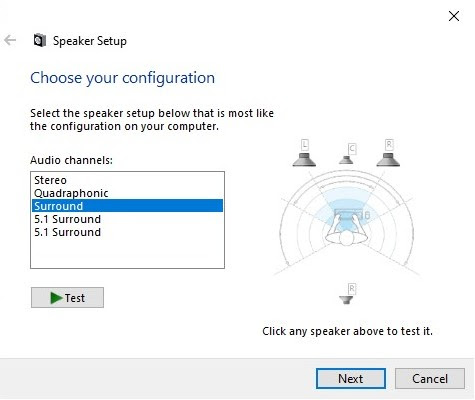
Most music recordings are stereophonic, i.e. with two channels, and the best quality for their recording is provided by digital technology. Nevertheless, as early as 1940, for the animated Disney film Fantasia, an analog recording was made with 3 soundtracks, which was played in a cinema using 54 speakers.
In the 1970s, analogue 4-channel recordings also appeared, which were encoded using various methods and offered on vinyl records. They were also available without encoding on 1/4 inch tapes. They were offered on reels or in 8-track cassettes, more about which in the text entitled 8-track cartridge player inspires PC4uMusic configurations.
The JVC 4ME - 4804 shown in the illustration was for playing cassettes, on which the quality of the recording left much to be desired. However, the concept of this device is still the inspiration for the PC4uMusic configuration for playing music from digital recordings, and these can be copied from analogue ones, which also applies to quadraphonic ones.

The story of the quadraphonic recording The Dark Side of the Moon turned out to be very interesting. The uncoded 4-channel recording was offered on a cassette in the US with the number 8XW-11163, and in the UK Q8-SHVL 804. The cassette has 1/4 inch tape, which moves at a speed of 3 3/4 ips, but the track is half as narrow as in the reel-to-reel offer.

The recording offered on a 7-inch reel with a 4-track tape and at a speed of 9.5 cm/s was encoded with Stereo Quadraphonic in 2 channels. The Wikipedia entry on SQ explains a bit here: Of Pink Floyd's The Dark Side of the Moon, engineer Alan Parsons recalled: "It was certainly the band's intention, when we recorded the album, to mix in quad. All the effects on 'Money ' and other tracks were recorded on four-track, so they could be heard in true quad on the final record… But by the time the mix stage was upon us, quad hadn't really taken off as a medium in the way it was expected to, so it was a little bit of an anticlimax. Then, as we know, the whole thing died a death."
In 2021, an EMI offer appeared with 250 copies of the studio tape, but it is most likely stereo only. Wikipedia also has information about the recording of The Dark Side of the Moon and in the paragraph entitled 30th-anniversary 5.1 surround sound mix an explanation is given: A quadraphonic mix, created by Alan Parsons, was commissioned by EMI but never endorsed by Pink Floyd, as Parsons was disappointed with his mix. For the album's 30th anniversary, an updated surround version was released in 2003. The band elected not to use Parsons' quadraphonic mix, and instead had the engineer James Guthrie create a new 5.1 channel surround sound mix on the SACD format. Guthrie had worked with Pink Floyd since their eleventh album, The Wall, and had previously worked on surround versions of The Wall for DVD-Video and Waters' In the Flesh for SACD. In 2003, Parsons expressed disappointment with Guthrie's SACD mix, suggesting he was "possibly a little too true to the original mix", but was generally complimentary. The 30th-anniversary edition won four Surround Music Awards in 2003, and sold more than 800,000 copies.

The PC4uMusic configuration allows you to deliver a signal to
four speakers in the room, and Microsoft's new proposal with their
arrangement works well with ambiophonics, quadraphonics and Home Theater. All available recordings can be played with the same equipment. Putting many better quality speakers in the house is not very practical. A more convenient setup is with 4 speakers: right, center, left and back, which works best with the reference program for the PC4uMusic configuration AIMP, but this may be too much of a challenge for the average user. It is easier with the program foobar2000, where you just need to install the Spatial Audio Output plug-in, which will handle the appropriate setting with surround sound in the Microsoft system driver in the PC, which has an output for surround sound.

PPCs have had the ability to play music with surround sound for years, and the latest solution was presented in more detail by Killian Bellow in a text published on September 14, 2024, titled: Got high-end speakers? Here's how to make the most of them by enabling spatial audio in Windows 11. He rightly points out that before we dive into enabling spatial audio on Windows 11, there are a couple of things to bear in mind. First, while Microsoft says that while spatial audio works with all great headphones, TVs, home theater setups, and soundbars, the company's own solution — Windows Sonic — is designed exclusively for headphones, which generally only have two drivers. For more complex setups with multiple speakers, you'll need to use Dolby Atmos and compatible hardware. By the term headphones he meant that they are 2 electroacoustic transducers in which the electric current becomes two acoustic waves that reach the right or left ear completely separately.

He also states that the major disadvantage to Dolby Atmos is that it’s not free to use. Your computer or sound device may have shipped with a trial of the feature, which will allow you to use it free for a period of time, but in many cases, you will eventually have to pay for an Atmos license. This is another valid point, because the software for Atmos is not entirely worth the price you have to pay, especially when it comes to playing music.
The author of the text also reminds that not every setup is properly equipped to handle spatial audio. If you don’t notice an improvement after enabling spatial audio, it may be that the sound device you’re using wasn’t designed to deliver 3D audio.

He also concluded that not all content is suited to spatial audio, so you may find that certain things sound the same as they did before or worse. Movies, TV shows, and games that are typically created with multi-directional audio effects usually work best, whereas many music tracks that were released in simple stereo can produce mixed results. These doubts about music change when the equipment is properly set up. This is the essence of the matter with PC4uMusic configurations, which are not for testing functions in the hardware, but for playing music. Every computer is just a mindless device that gains practical value only after installing the software. It can also be configured to faithfully play music. In addition, computers can be divided into those where installations are more or less easy to adjust the equipment to your own needs. Many musicians believe that Mac is the only right computer for them, because they know nothing about other possibilities.


Now this topic looks a bit different, because of the new solution, which is mentioned in the text "A historic launch for Eclipsa Audio in Las Vegas will change a lot"
ReplyDeletehttps://audiophilepc.blogspot.com/2025/04/a-historic-launch-for-eclipsa-audio.html
In video content, audio is just as essential as the visuals, playing a key role in immersion and making viewers feel as if they are part of the scene. To create a truly optimized sound experience, Samsung Electronics collaborated with Google to develop Eclipsa Audio — a cutting-edge 3D audio technology officially introduced through Samsung TVs last month at the Consumer Electronics Show (CES) 2025 in Las Vegas.
Deletehttps://news.samsung.com/global/eclipsa-audio-ushering-in-a-new-generation-of-3d-sound-with-samsung
LAS VEGAS, Jan. 7, 2025 /PRNewswire/ -- Spatial9, a pioneer in immersive audio technology, has partnered with Google and Music AI to introduce the world's first immersive music rendered in Eclipsa Audio (based on IAMF). This collaboration marks a transformative leap in sound innovation, now making Spatial9 content available globally on YouTube by using Eclipsa Audio format. At launch, Spatial9's immersive audio rendering technology is exclusively accessible through Music AI, with potential for availability on other platforms in the future.
Deletehttps://www.prnewswire.com/news-releases/google-spatial9-and-music-ai-debut-eclipsa-audio-immersive-format-at-ces-2025-302344338.html
Dolby: What is Spatial Audio?
ReplyDeletehttps://www.dolby.com/experience/home-entertainment/articles/what-is-spatial-audio/#whatisspatialaudio
Fantasound: in 1940, the ancestor of Dolby Atmos and DTS:X…
ReplyDeletehttps://blog.son-video.com/en/2022/03/fantasound-in-1940-the-ancestor-of-dolby-atmos-and-dtsx/